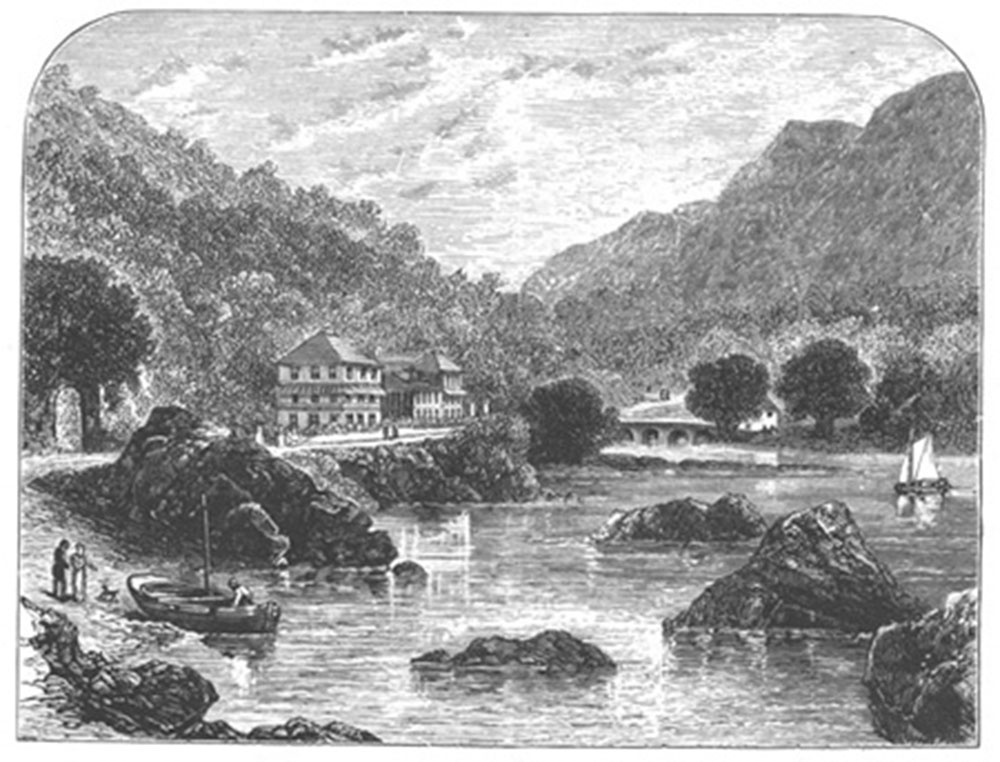Glengariff, Killarney, and Valentia - Irish Pictures (1888)
From Irish Pictures Drawn with Pen and Pencil (1888) by Richard Lovett
Chapter V: Glengariff, Killarney, and Valentia
« Previous Page | Book Contents | Next Page »
THERE are three main routes from Cork to Killarney. The tamest is by rail via Mallow; the most adventurous is by rail to Macroom, and thence to Killarney by the north road, as it is called, one of the finest drives in South-western Ireland, running through the country of the MacCarthys, with their ruined castles, and enabling the traveller to see Gougane Barra and the Pass of the Deer. The former is a lonely lake, lying embosomed in a great hollow formed by the mountains, which tower in parts almost perpendicularly above it. In the centre of the lake is an islet sacred to St. Finn Bar, which was for ages the object of special pilgrimages. The scenery here, for wild magnificence and power to touch the imagination, can hold its own with any in this region—so full of grand mountain and lake solitudes. The Pass of the Deer is a deep mountain cleft about two miles in length, 'the most sternly grand defile in Ireland, a scene of utter loneliness, where no song of bird or hum of bee breaks the monotonous stillness, save where the ripple of numerous sparkling rills course down the side of the acclivities. There are immense masses of rock seemingly poised in the air, almost perpendicularly on either side, clothed with stunted arbutus, rowan-tree, yew and holly, while huge projecting cliffs ever and anon seem threatening to bar the visitor's progress.' Here the outlawed O'Sullivans and O'Learys long defied the Government, and in 1822 the adherents of Captain Rock for a long time held possession of the pass, until dislodged by Lord Bantry and the military. It is a district well adapted for lawlessness of this kind.
But the popular route is by way of Bantry and Glengariff. This takes the traveller along one of the roads in Ireland most frequented, at least in the tourist season; but it also has compensations, inasmuch as it offers some most magnificent drives, and at the chief stopping points some of the very best hotels in Ireland are to be found. A short but pleasant railway journey from Cork enables the visitor to see the pretty country on the road to Bandon, to catch a good passing glimpse of that well-situated town, to see something of the wildest parts of County Cork, and finally brings him to Bantry, at the head of the famous bay of the same name. Here, if disposed to stop, he will find very comfortable accommodation, and although the little town presents an ancient appearance, and has a fish-like odour, there is nothing in it that need detain him long. But with the drive to Glengariff the beauties of this region begin to reveal themselves. The road winds along the north-eastern shores of Bantry Bay, which are somewhat hilly, affording consequently beautiful and ever-varying views. Whether the drive be taken in the full light of the midday sun, or when the softer lights and the shadows of evening are over the landscape, it will linger long in the memory. The noble expanse of the bay, the lofty peaks of the Sugar Loaf and other distant mountains, the fine bold rock contours, the little streams that ripple down from the surrounding mountains, the splendid colourings of sea and sky and rock and heath, all combine to heighten the enjoyment of the traveller. Especially fine are the views when the approach of evening tends to deepen the shadows and to robe the more distant prospects in a lovely purple haze.

